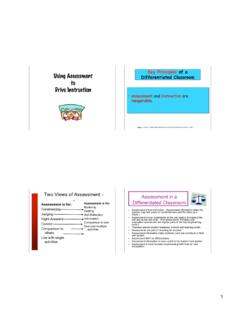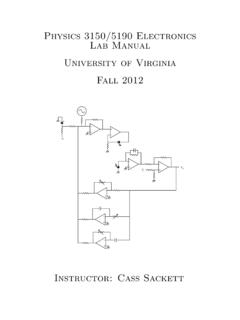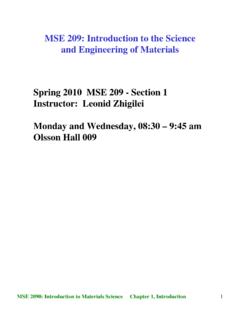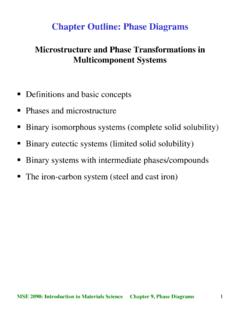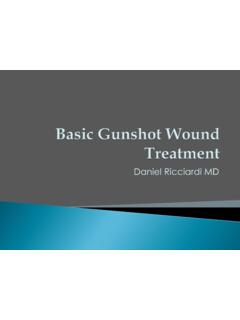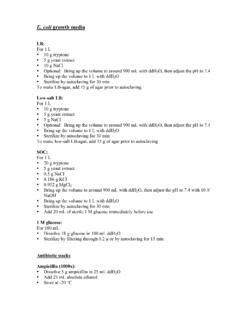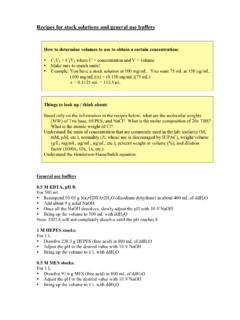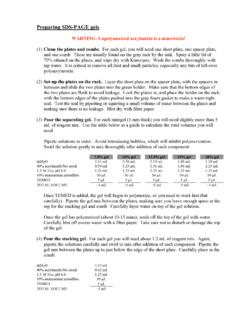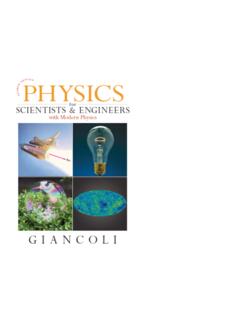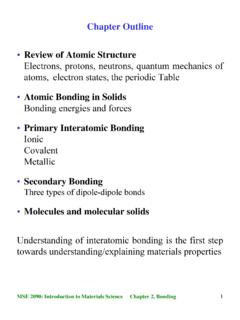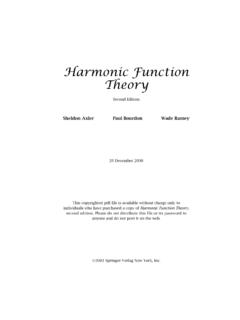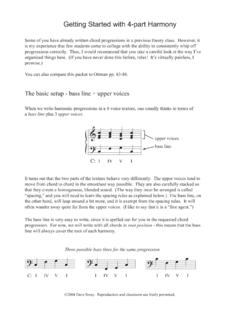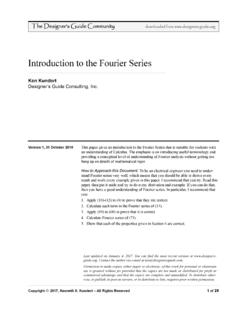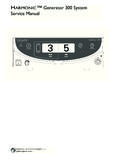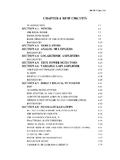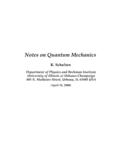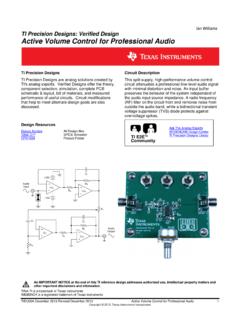Transcription of Torsion in Structural Design - people.Virginia.EDU
1 Torsion in Structural Design 1. Introduction Problems in Torsion The role of Torsion in Structural Design is subtle, and complex. Some torsional phenomena include (a) Twist of beams under loads not passing through the shear center (b) Torsion of shafts (c) Torsional buckling of columns (d) Lateral torsional buckling of beams Two main types of situation involve consideration of Torsion in Design (1) Member's main function is the transmission of a primary torque, or a primary torque combined with bending or axial load (Cases (a) and (b) above.) (2) Members in which Torsion is a secondary undesirable side effect tending to cause excessive deformation or premature failure. (Cases (c) and (d) above.) Torsion in Structural Design - Notes 11/30/01 2 Development of Torsional analysis- A few key contributors 1853 - French engineer Adhemar Jean Barre de Saint-Venant presented the classical Torsion theory to the French Academy of Science 1899 - A.
2 Michell and L. Prandtl presented results on flexural-torsional buckling 1905 - S. P. Timoshenko presented a paper on the effects of warping Torsion in I beams 1909 - C. Bach noted the existence of warping stresses not predicted by classical Torsion theory when the shear center and centroid do not coincide. 1929 - H. Wagner began to develop a general theory of flexural torsional buckling V. Z. Vlasov (1906-1958) developed the theory of general bending and twisting of thin walled beams 1944 - von Karman and Christensen developed a theory for closed sections (approximate theory) 1954 - Benscoter developed a more accurate theory for closed sections. Numerous other contributors, these are just a few highlights. Torsion in Structural Design - Notes 11/30/01 3 2.
3 Uniform Torsion of Prismatic Sections Consider a prismatic shaft under constant twisting moment along its length. Classical theory due to St Venant. Assume Cross-sections do not distort in plane during twisting, so every point in the section rotates (in plane) through angle )(x about the center of twist. Out of plane warping is not constrained Out of plane warping does not vary along the bar The resulting displacement field is dxdyxxywdxdzxxzvzydxdu = = = = =)()(),( Torsion in Structural Design - Notes 11/30/01 4 In plane displacements v and w are seen from the figure Torsion in Structural Design - Notes 11/30/01 5 Out of plane distortion (warping) of the section is assumed to vary with the rate of twist dxxd)( = =constant = xx)( and to be a function of the position (y,z) on the cross-section only.
4 Several models may be constructed Warping function model. Conjugate Harmonic function model St Venant's stress function model Torsion in Structural Design - Notes 11/30/01 6 Warping Function Model Substituting the displ. fields into the diff. eq. of equilibrium from elasticity, we obtain 022222= = + zy (Laplace's equation) with nznyyazan = where n is the normal direction to the boundary, and ),(nznyaa are the components of the unit normal vector n on the boundary. It can be shown that the St Venant torsional stiffness of the section is given by dAzzyyzyJA ++= 22 and that the angle of twist is related to the torque by LJGT = or dxdJGT = a result that reduces to the usual polar moment of inertia when the section becomes circular, and the warping function vanishes.
5 Problem: The eqn. is hard to solve with the given. Torsion in Structural Design - Notes 11/30/01 7 St Venant's Stress Function Model Assume that the non-zero stresses xzxy , are related to a stress function ),(zy by yzxzxy = = The function ),(zy automatically satisfies equilibrium. In order for the resulting displacements to be compatible ( satisfy continuity) the = = + GdxdGyy222222 be satisfied, where G=the shear modulus. The boundary conditions for this model are = onconstant ),(yx where is the boundary of the section. In many cases, it is convenient to simply take =0 on the boundary. Given the stress function, it can be shown that =AdydzzyJ),( over the section.
6 Torsion in Structural Design - Notes 11/30/01 8 This is somewhat easier to solve because of the simpler We are particularly interested in rectangular sections. Consider such a section, of dimension 2 x 2 , as shown. It can be shown (using a Levy type solution) that, for this section = = ,..5,3,12/)1(3322cos)2/cosh()2/cosh(1)1( 132nnynnznnG The corresponding stresses are = = ,..5,3,12/)1(2222sin)2/cosh()2/cosh(1)1( 116nnxzynnznnG = = ,..5,3,12/)1(2222cos)2/cosh()2/sinh()1(1 16nnxyynnznnG Torsion in Structural Design - Notes 11/30/01 9 is shown below for two sections Assume overall dimensions b=2 , t=2.
7 Assume that b>t. In general, it is useful to write dxdktG = max btkJ31= Then, since T max, we may write btkT22max= Torsion in Structural Design - Notes 11/30/01 10 Values of the coefficients are tabulated below for different aspect ratios Table 1 Coefficients for Torsion of a Rectangular Section b/t k k1 k2 3 4 5 10
8 It is seen that for the thin section, the response away from the ends is almost independent of y. Hence, a simplified model takes the form 0)( subject to 222= = Gdzd Torsion in Structural Design - Notes 11/30/01 11 This leads to the simple solution = 2221)(zGz with resulting shear stress () = /2zGxy Hence, at z=t/2, dxdGtGt = = max Integrating this approximate function over the area, 331btJ= 00. 20. 40. 60. 811. 21 1. 2 1. 5 2 2. 534510*kk1k2 Torsion in Structural Design - Notes 11/30/01 12 consistent with the limit of the 2-D solution as the width to thickness ratio approaches.
9 The shear stresses in a narrow rectangular beam are as shown below Thin-walled open section beams Some thin walled open sections: angles, channels, W and S sections, T sections, etc. Key result 1. The section torsional stiffness J is approximately equal to the sum of the J's for the constituent thin walled plates. Thus, ==niiitbJ1331 Key result 2. The maximum shear stress is estimated as JTtimaxmax= except that larger stresses may occur at the corners . Key result 3. The shear flow around the section, caused by St Venant Torsion , is as shown below. Torsion in Structural Design - Notes 11/30/01 13 That is, the stresses vary linearly through the thickness on any of the constituent plates, achieving a maximum on each edge.
10 Torsion in Structural Design - Notes 11/30/01 14 3. Shear Stresses due to bending - thin walled open sections Provides important background needed for analysis of Torsion Three items are shear stresses and shear flow concept shear center sectorial moments These items can be obtained from a generalization of the analysis studied in undergraduate Mechanics of Materials. We summarize the results of the analysis below. Normal Stresses and Resultants From generalized analysis of beams, zIIIMIMIyIIIMIMI yzzzyyzyzyzzyzzzyyyyzzyyxx22 = where Torsion in Structural Design - Notes 11/30/01 15 ==AzzAyydAyIdAzI22 = the moments of inertia.
